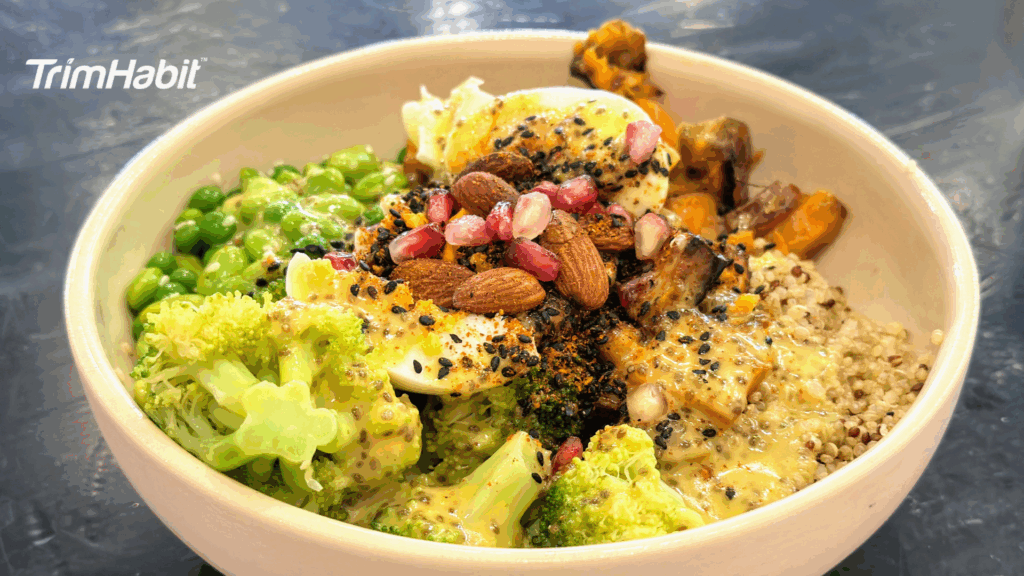Ever wonder what the best omelet ingredients to lose weight are? Having a clear understanding of the right ingredients not only simplifies your diet but it also offers benefits to your health.
The right omelet ingredients can help you fill up on fewer calories, give you more energy and help keep you full for hours. Not to mention, certain ingredients are great when paired with other ingredients that are good for you and your body.
In this article, you will learn the most beneficial, healthy, and effective best omelet ingredients to help you naturally lose weight.
What Is An Omelet?
An omelet is a dish made by cooking beaten eggs in a pan with various fillings like cheese, vegetables, and meat. The French origin of the word omelet is “thin, little plate,” which alludes to the omelet’s flat shape.
They can be customized to suit your preferences and dietary needs, and can range from simple and classic to more elaborate and gourmet preparations. Omelets are a popular and versatile dish enjoyed by people around the world.
You can have omelets as a healthy breakfast replacement, but you can also have them for lunch or dinner, and are often accompanied by toast, salad, or other sides.
Can You Lose Weight While Eating An Omelet?
Depending on how you make it, eating an omelet can help you lose weight when combined with healthy eating and daily exercise.
Use a lot of fresh vegetables, moderate amounts of cheese, and egg whites or egg beaters rather than whole eggs to make a nutritious omelet.
How Many Calories Are There In A Basic Omelet?
The number of calories in a basic omelet can vary depending on the ingredients used and the size of the omelet. However, a basic omelet with two large eggs and a tablespoon of butter or oil to cook it in has an estimated calorie count of around 300-400 calories.
According to the USDA, a two-egg omelet provides 188 calories, 12.9 grams of protein, and 14.2 grams of fat. Only 0.7 grams of carbs are in an omelet1.
Best Omelet Ingredients To Lose Weight
If you are looking for omelet ingredients that are both delicious and can help with weight loss, here are some options:
1. Egg Whites or a Combination of Egg Whites and Whole Eggs
Egg whites are low in calories, high in protein, and contain no fat or cholesterol, making them an excellent weight-loss choice.
2. Fresh Vegetables
Fresh veggies like spinach, mushrooms, onions, peppers, and tomatoes are low in calories, fiber, and nutrients and can help fill you up without adding many calories.
3. Herbs and Spices
Adding herbs and spices like oregano, basil, cilantro, cumin, or black pepper can add flavor to your omelet without adding calories or fat.
Instead of using salt, which can increase your sodium intake, try using herbs and spices.
4. Low-fat Cheese
Low-fat cheese can add flavor and protein to your omelet without adding too many calories. You can use varieties like feta, goat cheese, mozzarella, or sharp cheddar cheeses.
5. Lean Protein
Adding lean protein like diced chicken, turkey, or ham can provide a good source of protein with a minimal calorie impact.
6. Butter or Olive Oil
You can use unsalted butter when making a healthy omelet recipe. Butter adds a rich, creamy flavor to the eggs, which enhances the taste of the omelet. While butter is high in calories and fat, it contains healthy saturated fats and other nutrients such as Vitamin A and D that are essential for good health.
However, if you wish to lessen calorie intake, you may opt to replace butter with olive oil. Olive oil is a quick fix that will reduce the amount of saturated fat in your omelet without affecting the flavor or texture.
While making an omelet using olive oil, cook it over low to medium heat. Heating olive oil in medium heat will keep its nutritional value.
Healthy Omelet Recipes
Omelets can be a healthy and satisfying food for weight loss and make a great breakfast. Keep omelets’ ingredients to a minimum and choose protein and fiber combinations.
Here are some low-calorie omelet recipes that can help you achieve your weight-loss goals:
- One Egg plus Two Egg White Omelet
You can make an omelet using one whole egg, and then two egg whites that will help reduce calories and cholesterol by trying to eliminate some of the yolks.
This low-calorie recipe is excellent for weight loss since it contains fewer calories but more nourishment than a typical egg white omelet.
Egg yolks will provide you with nutrition, flavor, and color since choline, found in the yolk, supports brain function2.
- Smoked Salmon and Eggs Omelet
Salmon contains omega-3 fatty acids, which are known to reduce inflammation. This healthy omelet recipe not only contains omega-3 fatty acids but is also rich in protein and flavorful.
For extra benefit, you can add egg mixture with plain, non-fat Greek yogurt, which provides protein, calcium, and increased bacteria for your gut – as a healthy gut contributes to weight loss3.
Fresh chives can be used as a garnish to add flavor, fiber, and anti-inflammatory antioxidants.
- Caramelized Onion with Egg Omelet
Onions provide fiber and antioxidants, while eggs provide protein. Also, while caramelization makes it delicious on its own, you may add some cheddar cheese, goat, or feta.
It would be best to use little cheese to lower saturated fat and calories in this healthy meal.
- Egg, Tomatoes, and Red Bell Pepper Omelet
You can use a regular tomato or cherry tomatoes to add flavor.
You may include red bell pepper or jalapeno to make it a weight loss omelet meal to add a little spicy flavor.
Spicy foods slightly boost metabolic rate for a period of time after eating them4.
- Eggs with Spinach Omelet
Spinach omelet offers an excellent source of fiber, protein, and antioxidants. You can throw in avocado and whole milk for added healthy fat.
Use more vegetables, leafy greens, and whole eggs.
- Cheese Omelet
This classic omelet incorporates shredded cheese into the egg mixture before cooking. Use only a small amount of cheese to keep the calorie count in check.
- Western Omelet
Also known as a Denver omelet, this variation includes diced ham, onions, green bell peppers, and shredded cheddar cheese.
- Spanish Omelet
This omelet is made with potatoes, onions, and green peppers and often serves as a topping in Spain.
- Mushroom Omelet
Mushroom omelet features sautéed mushrooms in the filling. The mushrooms are typically sliced and cooked in butter or oil until they are tender and slightly browned.
- Mediterranean Omelet
This omelet includes tomatoes, olives, feta cheese, and fresh herbs such as parsley or oregano.
- Avocado and Tomato Omelet
Making this omelet includes diced avocado and tomato in the filling and is often topped with a drizzle of lime juice and a sprinkle of salt and pepper.
- Philly Cheesesteak Omelet
This omelet includes thinly sliced steak, sautéed onions, peppers, and melted provolone cheese in the filling.
White Omelets
A white omelet is made with egg whites only, without any yolks. It is a popular option if you are looking for a low-fat or low-cholesterol meal, as egg yolks contain most of the fat and cholesterol in an egg.
White omelets can be filled with various ingredients like vegetables, cheese, and meats, just like traditional omelets. You can also add a small amount of milk or cream to the egg whites to make them fluffier.
Low-Calorie Omelets
A low-calorie omelet is a dish made with ingredients lower in calories and fat than traditional omelets. It typically contains fewer calories than a regular omelet, making it a good choice if you are watching your calorie intake.
Low-calorie omelets can be made with egg whites or a combination of whole eggs and egg whites, which are lower in calories and fat than whole eggs. They can also include low-calorie fillings like fresh vegetables like spinach, mushrooms, peppers, onions, and tomatoes, and lean proteins like chicken breast or turkey sausage.
Low-calorie omelets are often cooked with cooking spray or in a non-stick pan to reduce the amount of added fat, and cheese is typically used sparingly or avoided altogether to keep the calorie count low.
Overall, a low-calorie omelet is a healthier option if you are looking to reduce your calorie intake and still enjoy a satisfying meal.
While these low-calorie omelet combinations can aid in weight loss, watching your portion sizes and incorporating regular exercise into your routine is important.
Here are some examples of a low-calorie omelet:
Pepper and Asparagus in an Egg White Omelet
- two egg whites.
- a tsp. of butter
- One tablespoon of finely chopped onion
- two tablespoons of finely sliced red bell pepper
- two tablespoons chopped asparagus
Egg Omelet with Pepper and SSpinach
- two scrambled eggs
- 1/9 cup butter
- one teaspoon of finely chopped onion
- two tablespoons of small-cut red bell pepper
- 1/2 cup of fresh spinach or baby spinach
- When needed, add salt and pepper
Asparagus and Mushroom Omelet
- two scrambled eggs
- a tsp. of butter
- two finely sliced mushrooms
- two tablespoons chopped asparagus
- fresh spinach, half a cup
- pepper and salt as desired
How To Make A Low-Calorie Omelet?
- Use egg whites.
Egg whites are lower in calories and fat than whole eggs, so using only egg whites or a combination of egg whites and a few whole eggs can significantly reduce the calorie count of your omelet.
- Use low-fat fillings.
Opt for low-fat fillings such as fresh vegetables like spinach, mushrooms, peppers, onions, and tomatoes. You can also use lean proteins like chicken breast or turkey sausage instead of fatty meats like bacon or sausage.
- Use cooking spray instead of oil.
Instead of using oil or butter to grease the pan, use cooking spray or a non-stick pan to reduce the amount of added fat.
- Limit cheese.
Cheese is high in calories and fat, so try to avoid it or use it sparingly in your omelet. If you really want cheese, try using a low-fat option like reduced-fat cheddar or part-skim mozzarella.
- Keep portions small.
Omelets can be high in calories, especially if they are filled with lots of ingredients, so try to keep portions small and focus on adding more vegetables for volume.
- Limit meats.
Meats like bacon, sausage, and ham are high in calories and fat, so use them sparingly or choose leaner options like turkey sausage or chicken breast.
Instead of relying on meat as the primary source of protein in your omelet, consider using other options like egg whites or low-fat cheese or incorporating vegetarian protein sources like tofu or beans. This can help reduce your omelet’s overall calorie count while still providing plenty of satisfying flavor and nutrition.
Instructions For Making Omelets
- Whisk together the eggs in a bowl with salt and pepper.
- Melt the butter or oil in a non-stick pan over medium-high heat.
- Pour the whisked eggs into the pan and let them cook for about 20-30 seconds until the edges start to set.
- Use a spatula to gently lift the edges of the omelet and allow the uncooked egg to flow underneath. Continue to cook for another minute or until the top of the omelet is mostly set.
- Add your desired fillings to one side of the omelet.
- Fold the other half of the omelet over the fillings to form a half-moon shape.
- Cook for another 20-30 seconds until the fillings are heated through and the eggs are fully cooked.
- Slide the omelet onto a plate with a spatula and serve hot.









